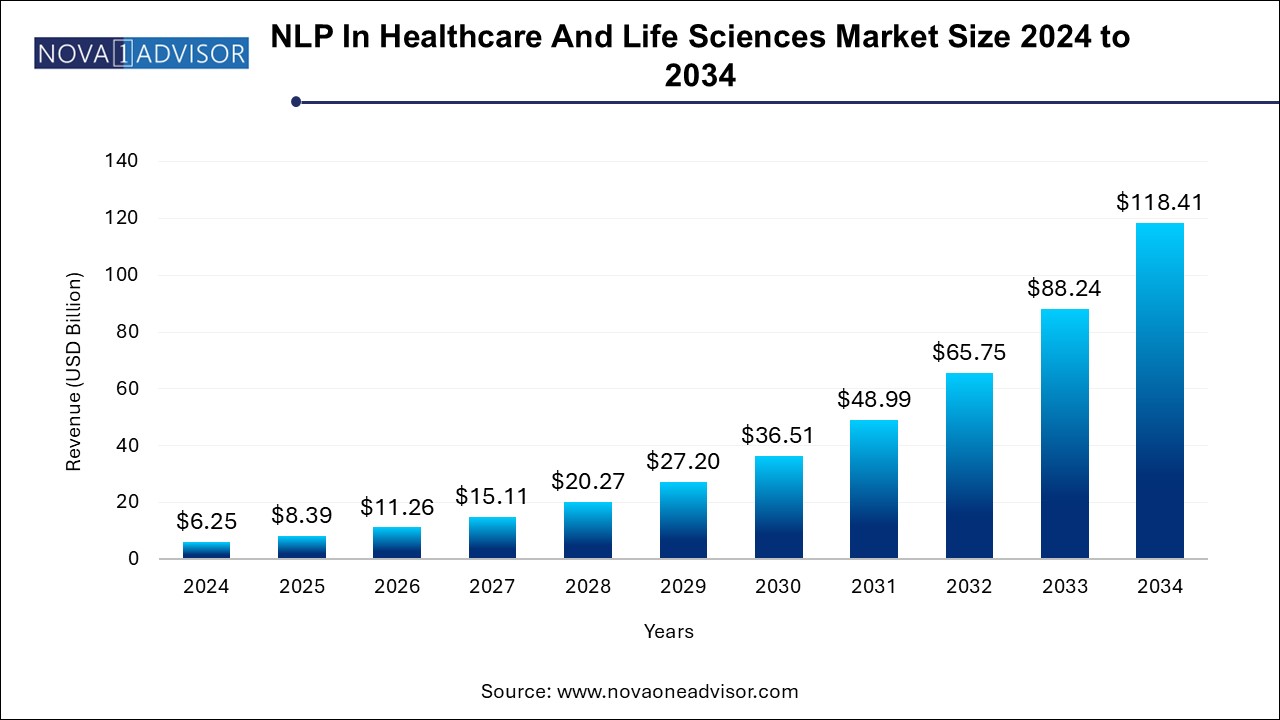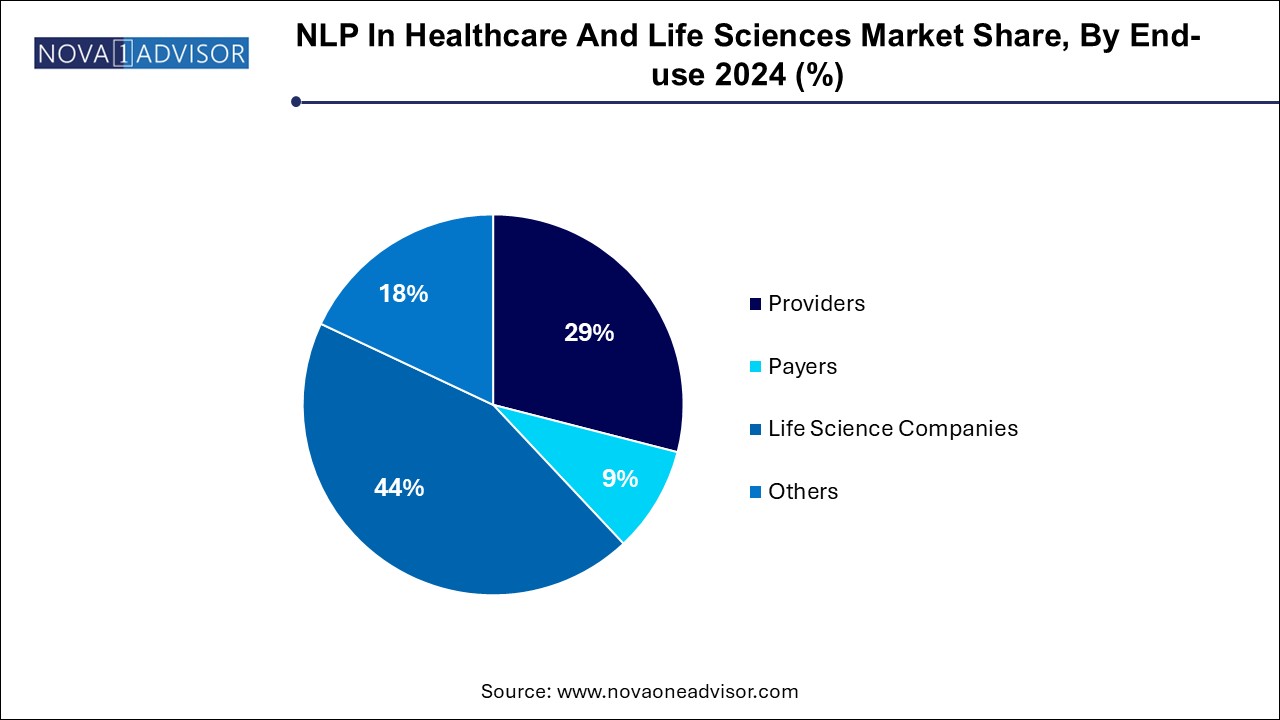NLP In Healthcare And Life Sciences Market Size and Trends
The NLP in healthcare and life sciences market size was exhibited at USD 6.25 billion in 2024 and is projected to hit around USD 118.41 billion by 2034, growing at a CAGR of 34.2% during the forecast period 2024 to 2034.

NLP In Healthcare And Life Sciences Market Key Takeaways:
- The smart assistance segment held the largest share of 18.71% in 2024.
- The classification and categorization segment is expected to grow at the fastest CAGR of 39.0% over the forecast period.
- The Life Science Companies segment held a significant market share of 44.0% in 2024.
- The providers segment is anticipated to grow at the fastest CAGR of 36.3% from 2024 to 2034.
- North America NLP in Healthcare and Life Sciences marketaccounted for the largest global market share of 43.60% in 2024.
Market Overview
The Natural Language Processing (NLP) in Healthcare and Life Sciences Market is undergoing a transformative evolution, driven by the increasing demand for structured insights from unstructured medical data. NLP, a subfield of artificial intelligence (AI), enables computers to understand, interpret, and generate human language in a way that is both meaningful and valuable. In the context of healthcare and life sciences, NLP is enabling a wide range of applications—from extracting insights from electronic health records (EHRs) and clinical notes to automating administrative tasks, improving diagnostics, supporting drug discovery, and enhancing patient engagement.
The explosion of digital health data—including physician notes, lab reports, diagnostic imaging results, patient feedback, and scientific literature—has created a pressing need for intelligent systems that can interpret vast volumes of unstructured text. NLP tools are increasingly used to convert this information into structured data, unlocking insights that were previously hidden. Hospitals, payers, pharmaceutical companies, and research institutions are now leveraging NLP to improve clinical outcomes, reduce administrative burden, streamline research, and personalize patient experiences.
Major Trends in the Market
-
Increased Integration of NLP with Electronic Health Records (EHRs): NLP tools are being integrated with major EHR platforms to extract clinical insights, summarize notes, and identify care gaps.
-
Rising Use of NLP in Clinical Documentation Improvement (CDI): NLP supports accurate medical coding and documentation, thereby optimizing reimbursements and reducing claim denials.
-
Growth in Patient Sentiment and Experience Analysis: Hospitals and providers use NLP-powered analytics to evaluate patient feedback and satisfaction trends in real-time.
-
Surge in NLP for Drug Discovery and Genomic Data Interpretation: Life sciences companies employ NLP to mine research literature, clinical trial data, and genomic records for faster hypothesis generation.
-
Emergence of Voice-enabled Digital Assistants: Smart assistants powered by NLP are transforming physician workflows by enabling hands-free data entry and voice-activated search in medical databases.
-
Multilingual NLP Development: With global demand increasing, tools are being trained to handle multiple languages and dialects for broader accessibility.
-
Cloud-based NLP Platforms: There is a growing preference for cloud-hosted NLP services due to scalability, real-time updates, and integration flexibility.
Report Scope of NLP In Healthcare And Life Sciences Market
| Report Coverage |
Details |
| Market Size in 2025 |
USD 8.39 Billion |
| Market Size by 2034 |
USD 118.41 Billion |
| Growth Rate From 2024 to 2034 |
CAGR of 34.2% |
| Base Year |
2024 |
| Forecast Period |
2024-2034 |
| Segments Covered |
Technique, End-use, Region |
| Market Analysis (Terms Used) |
Value (US$ Million/Billion) or (Volume/Units) |
| Regional Covered |
North America; Europe; Asia Pacific; Latin America; MEA |
| Key Companies Profiled |
IBM; Microsoft; Google (Alphabet Inc.); IQVIA; Dolbey Systems, Inc.; Averbis; Press ganey; lexalytics; Clinithink; Hewlett Packard Enterprise Development LP; Apixio; Edifecs; JohnSnow Labs; Itrex Group; CloudMedx; BenevolentAI; Tempus. |
Key Market Driver – Rising Volume of Unstructured Clinical Data
A critical driver fueling the NLP in healthcare and life sciences market is the exponential rise in unstructured clinical data. Over 80% of healthcare information exists in unstructured formats such as physician notes, pathology reports, radiology descriptions, and patient narratives. While structured data (like lab results or vitals) can be readily analyzed, the unstructured corpus holds valuable patient-specific insights that are often underutilized.
NLP bridges this gap by enabling the extraction and analysis of key clinical indicators from narrative texts. For instance, identifying early symptoms of disease progression or drug side effects buried in physician notes can lead to early intervention and improved patient safety. The implementation of NLP in health systems such as the Mayo Clinic and Kaiser Permanente has demonstrated significant benefits in real-time risk stratification and quality improvement programs. As healthcare systems aim to transition from volume to value-based care, unlocking the potential of this unstructured data is essential—making NLP indispensable.
Key Market Restraint – Data Privacy and Ethical Concerns
While NLP offers substantial value, one of the significant restraints in the market is concerns around data privacy, patient confidentiality, and ethical compliance. Healthcare data is highly sensitive, and extracting or processing it using AI and NLP algorithms introduces risks related to unauthorized access, data misuse, and re-identification of patients.
With stringent regulations such as HIPAA (Health Insurance Portability and Accountability Act) in the U.S., GDPR in Europe, and similar regional laws, healthcare organizations must ensure robust data anonymization, encryption, and audit mechanisms before deploying NLP solutions. Moreover, ethical challenges also arise around bias in NLP models, especially if the training data reflects systemic inequalities or demographic underrepresentation. These concerns can lead to hesitancy in adoption among providers and regulators, particularly in regions with less mature digital infrastructure or data governance policies.
Key Market Opportunity – NLP-Driven Clinical Decision Support Systems (CDSS)
An emerging opportunity within the market is the integration of NLP into Clinical Decision Support Systems (CDSS). CDSS enhances clinical workflows by offering evidence-based guidance at the point of care. By embedding NLP, these systems can extract patient history, correlate it with medical literature and treatment guidelines, and generate personalized care recommendations in real-time.
For instance, NLP can interpret patient symptoms recorded in notes, compare them with historical patterns or diagnostic databases, and alert physicians about potential complications or suggest alternative diagnoses. Hospitals like Mount Sinai and Cleveland Clinic are already piloting such intelligent CDSS models. Pharmaceutical companies, too, benefit from NLP-powered CDSS in optimizing protocol design and patient selection during clinical trials. As healthcare organizations continue to embrace AI for precision medicine and workflow automation, NLP in CDSS represents a compelling growth frontier.
NLP In Healthcare And Life Sciences Market By Technique Insights
Text analytics leads the market among NLP techniques, due to its ability to extract structured information from a wide variety of textual sources such as medical records, pathology reports, clinical trial data, and scientific publications. Text analytics is widely used in both payer and provider settings for clinical documentation improvement, adverse event detection, population health management, and post-market surveillance. Pharmaceutical companies rely on text analytics to mine massive scientific literature databases and identify potential drug targets or side effects.
On the other hand, smart assistance is emerging as the fastest-growing segment, owing to its transformative impact on clinician workflow, telehealth, and patient engagement. Voice-enabled assistants powered by NLP help physicians dictate notes, schedule appointments, retrieve drug information, and even interact with EHRs without manual typing. In patient-facing roles, chatbots equipped with NLP are handling routine queries, offering medication reminders, and delivering basic triage services. With the increasing maturity of voice recognition algorithms and integration with mobile health (mHealth) apps, the smart assistance segment is poised for rapid expansion, especially in outpatient and remote care settings.
NLP In Healthcare And Life Sciences Market By End-use Insights
The Life Science Companies segment held a significant market share of 44.0% in 2024. The industry increasingly relies on NLP to accelerate drug discovery, streamline clinical trial operations, and ensure regulatory compliance. NLP aids researchers in literature mining, trial protocol design, adverse event monitoring, and pharmacovigilance. With rising pressure to reduce time-to-market for new drugs, biopharma firms are embracing NLP to gain insights from R&D data, patents, and global regulatory databases. The use of NLP in genomic interpretation and target validation further drives its adoption in life sciences research.

Healthcare providers are the dominant end-users of NLP technologies, accounting for the largest market share due to their direct role in patient care delivery, documentation, and data analysis. NLP applications in hospitals range from auto-coding for billing, real-time transcription, clinical summarization, and predictive analytics. For instance, providers use NLP to flag high-risk patients based on historical records, aiding in population health initiatives and resource allocation. Additionally, NLP supports interoperability by enabling the extraction and standardization of data across different EHR systems.
NLP In Healthcare And Life Sciences Market By Regional Insights
North America holds the largest share in the NLP in healthcare and life sciences market, largely due to early technology adoption, advanced healthcare IT infrastructure, and supportive regulatory frameworks. The United States is at the forefront, driven by strong participation from health systems, research universities, and AI companies. Programs such as the ONC’s Interoperability Framework and widespread adoption of EHRs have created a data-rich environment conducive to NLP applications.
Furthermore, North American players like Nuance (a Microsoft company), IBM Watson Health, Amazon Comprehend Medical, and Google Cloud Healthcare NLP API continue to launch sophisticated NLP solutions customized for clinical settings. Academic collaborations between AI labs and medical institutions, along with robust funding from NIH and private investors, support the region’s innovation pipeline. The high burden of chronic disease and demand for value-based care models also incentivize NLP adoption in clinical workflows.
Asia Pacific is expected to register the highest CAGR through 2034, driven by massive digitization of healthcare systems, government initiatives, and the rise of tech-savvy populations. Countries such as China, India, Japan, and South Korea are witnessing significant investments in AI-powered health platforms, with NLP forming a critical component of clinical and research applications.
In India, AI startups like Niramai, Qure.ai, and Sigtuple are embedding NLP into radiology, oncology, and patient monitoring platforms. China’s Health Information Standardization efforts and its push toward unified electronic records are fueling demand for intelligent data extraction tools. Moreover, multilingual NLP development is gaining traction in this linguistically diverse region, with efforts focused on improving inclusivity and scalability. The growing use of cloud-based healthcare platforms and the rapid expansion of life sciences R&D in Asia are expected to further bolster the regional market.
Some of the prominent players in the NLP in healthcare and life sciences market include:
NLP In Healthcare And Life Sciences Market Recent Developments
-
March 2025 – Microsoft and Epic Systems expanded their partnership to integrate Microsoft Azure’s NLP capabilities into Epic’s EHR system, enhancing real-time clinical documentation tools across U.S. hospitals.
-
January 2025 – Google Cloud launched its Healthcare NLP API for public availability, enabling developers to extract medical insights from unstructured text, including clinical notes and lab reports.
-
December 2024 – Amazon Web Services (AWS) updated Amazon Comprehend Medical with multilingual support and contextual understanding features tailored for oncology and cardiology specialties.
-
November 2024 – IQVIA partnered with Roche to develop an AI-powered trial analytics suite that uses NLP to monitor patient-reported outcomes and protocol adherence in decentralized trials.
-
September 2024 – Oracle Health acquired Abridge, a voice-based clinical documentation company, to strengthen its NLP and speech analytics portfolio.
Segments Covered in the Report
This report forecasts revenue growth at country levels and provides an analysis of the latest industry trends in each of the sub-segments from 2021 to 2034. For this study, Nova one advisor, Inc. has segmented the NLP in healthcare and life sciences market
Technique
- Smart Assistance
- Optical Character Recognition
- Auto Coding
- Text Analytics
- Speech Analytics
- Classification and Categorization
End-use
- Providers
- Payers
- Life Science Companies
- Others
Regional
- North America
- Europe
- Asia Pacific
- Latin America
- MEA


